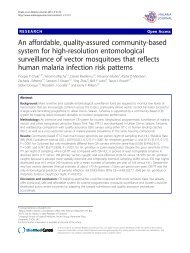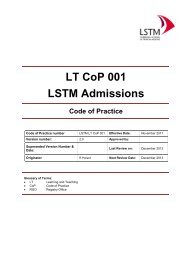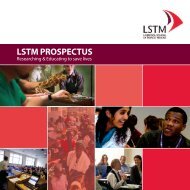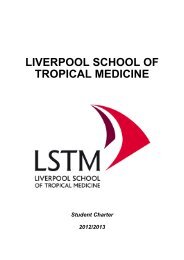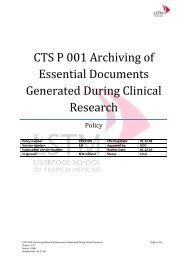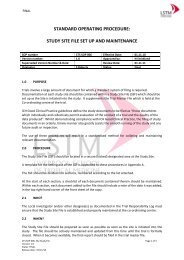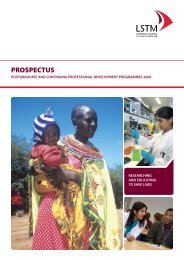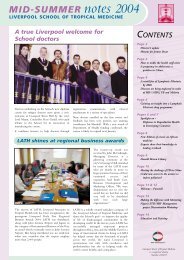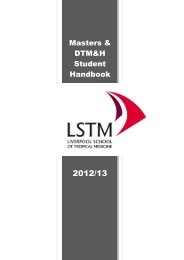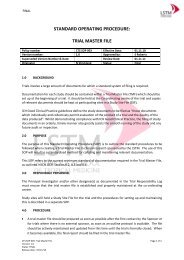Gender influences on child survival, health and nutrition: a ... - Unicef
Gender influences on child survival, health and nutrition: a ... - Unicef
Gender influences on child survival, health and nutrition: a ... - Unicef
You also want an ePaper? Increase the reach of your titles
YUMPU automatically turns print PDFs into web optimized ePapers that Google loves.
<str<strong>on</strong>g>Gender</str<strong>on</strong>g> Influences On Child Survival, Health And Nutriti<strong>on</strong>: A Narrative Review<br />
1 REVIEW OF STUDIES EXPLORING GENDER INFLUENCES ON CHILD<br />
SURVIVAL, HEALTH AND NUTRITION<br />
1.1 WOMEN’S STATUS AND INTRA-HOUSEHOLD BARGAINING POWER AND PROCESS.<br />
This secti<strong>on</strong> explores <strong>on</strong>e of the main ways in which women’s status (see box 1 below) impacts <strong>on</strong> <strong>child</strong><br />
<strong>health</strong> <strong>and</strong> nutriti<strong>on</strong> outcomes within the household through women’s bargaining power relative to<br />
other members of the household.<br />
A body of research spanning more than 20 years focusing <strong>on</strong> aspects of gender <strong>and</strong> <strong>child</strong> <strong>health</strong> <strong>and</strong><br />
nutriti<strong>on</strong> has found links between women’s status <strong>and</strong> <strong>child</strong> <strong>survival</strong>. As this is a well established<br />
literature, we have drawn <strong>on</strong> some key reviews <strong>and</strong> quantitative studies in order to highlight its<br />
relevance to <strong>child</strong> <strong>survival</strong> (Caldwell & Caldwell 1991) (Smith & Haddad 2000). In brief, the mechanisms<br />
hypothesised to explain the effect of women’s status <strong>on</strong> <strong>child</strong> <strong>survival</strong> include better literacy, better<br />
adherence to <strong>health</strong> services, more aut<strong>on</strong>omy, more bargaining power, more access <strong>and</strong> c<strong>on</strong>trol over<br />
resources. Am<strong>on</strong>g the dimensi<strong>on</strong>s of women’s status explored, maternal educati<strong>on</strong> is <strong>on</strong>e of the bestresearched<br />
mechanisms through which improvements in women’s status (i.e. through better educati<strong>on</strong><br />
for women) leads to gains in <strong>child</strong> <strong>health</strong> <strong>and</strong> nutriti<strong>on</strong>. This is explored in more depth next.<br />
Box 1: What is women’s status?<br />
Women’s ‘status’ refers to the positi<strong>on</strong> women hold vis-à-vis men in a given community or<br />
society which usually mediates their decisi<strong>on</strong>-making power <strong>and</strong> ability to access resources<br />
within the household or the wider community.<br />
Studies have adopted different approaches to measuring women’s status through proxy<br />
indicators. Caldwell’s review focuses <strong>on</strong> maternal educati<strong>on</strong> (discussed further in secti<strong>on</strong> 1.2.2).<br />
Others have combined measurements of women’s educati<strong>on</strong> with other indicators. For example,<br />
Smith <strong>and</strong> Haddad (2000) show that women’s status (as measured by female to male life<br />
expectancy) <strong>and</strong> improvements in women’s educati<strong>on</strong> (as measured by female sec<strong>on</strong>dary<br />
enrolments) are associated with positive impacts <strong>on</strong> nutriti<strong>on</strong>al status. The study estimates that<br />
improvements in women’s status account for 11.61% of global reducti<strong>on</strong>s in the proporti<strong>on</strong> of<br />
<strong>child</strong>ren who are underweight (low weight for age), <strong>and</strong> improvements in women’s educati<strong>on</strong><br />
sec<strong>on</strong>dary enrolments account for 43.01% of global reducti<strong>on</strong>s in the proporti<strong>on</strong> of <strong>child</strong>ren who<br />
are underweight (low weight for age). Taken together, the two indicators accounted for over<br />
half of the reducti<strong>on</strong>s in <strong>child</strong> underweight in the 1970-1995 period. More recently, Apodaca<br />
(2008) uses the ratio of female to male primary school enrolment as a proxy measure of women’s<br />
status in a multivariate statistical analysis of data from 137 developing countries <strong>and</strong> finds that<br />
more equal enrolment ratios are associated with reduced <strong>child</strong> stunting rates The effect of the<br />
ratio of female to male primary school enrolment was significant in four Ordinary Least Squares<br />
regressi<strong>on</strong> models used to measure the effects of <strong>health</strong> c<strong>on</strong>diti<strong>on</strong>s <strong>on</strong> <strong>child</strong>hood stunting [-0.22<br />
(0.13); -0.05 (0.14); -0.16 (0.13); -0.15 (0.13)] (Apodaca 2008).<br />
REVIEW OF STUDIES<br />
14



